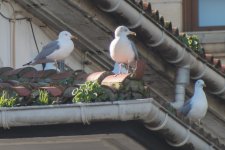First of all I have to say that I wouldn't dare to give this presumed ID (Larus smithsonianus) based only on my knowledge and with only this photograph. The fact is that there is a long-time (this is its 6th winter here) returning individual of this species at this small harbour (has got even a nickname, "Ondarru"), which has been seen by several experienced gull observers during the same days at the very same spot. I wonder if the one in the middle of the photo is THE bird.
I've based the presumed ID on pink coloured legs, pale mantle, very light eyes and extent of gonyal spot.
Unfortunately I don't have more photos, little after I located it all the gulls in the area flew away. Could it be instead another of the more frequent gulls in the area (YLG & LBBG), or these can be discarded? As far as I know there is no HG adult been reported from there these days.
Taken at Ondarroa harbour, Basque Country, last week
I've based the presumed ID on pink coloured legs, pale mantle, very light eyes and extent of gonyal spot.
Unfortunately I don't have more photos, little after I located it all the gulls in the area flew away. Could it be instead another of the more frequent gulls in the area (YLG & LBBG), or these can be discarded? As far as I know there is no HG adult been reported from there these days.
Taken at Ondarroa harbour, Basque Country, last week
Attachments
Last edited:







